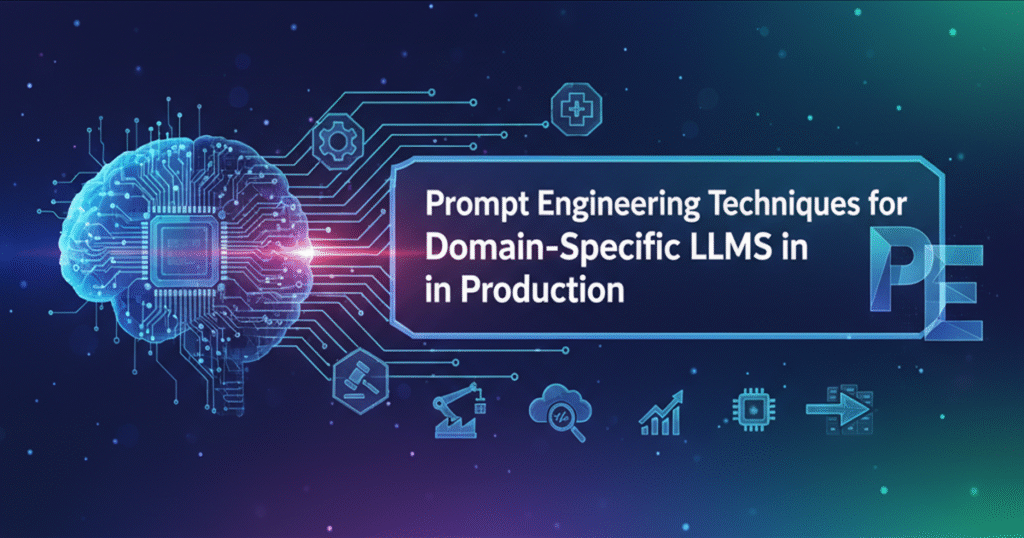Large Language Models (LLMs) are no longer confined to research labs or experimental chatbots. In 2025, they are becoming core to Enterprise AI — powering search, customer support, knowledge discovery, workflow automation, and decision-making systems.
But here’s the challenge: out-of-the-box LLMs are trained on vast internet data, not the unique needs of your enterprise. A healthcare model must understand clinical terms, a legal assistant must parse compliance documents, and a financial bot must interpret market data without hallucinations.
This is where Prompt Engineering Techniques make the difference. By combining Domain-Specific LLMs, Fine-Tuning, and Context-Aware Prompts, enterprises can bridge the gap between general-purpose AI and production-grade intelligence.

Why Prompt Engineering Matters for Production LLMs
Deploying Production LLMs is not just about getting answers — it’s about getting the right answers.
Poorly structured prompts lead to:
Inconsistent responses
Hallucinations (confidently wrong answers)
Irrelevant outputs
Lack of compliance alignment
Enterprises adopting Prompt Engineering Techniques can control model behavior, increase accuracy, and ensure that AI delivers consistent, trusted results in real-world workflows.
Key Prompt Engineering Techniques
1. Role Assignment Prompts
Clearly define who the model is supposed to be.
“You are a compliance officer reviewing GDPR clauses. Provide a summary with risk ratings.”
Benefit: Aligns outputs with domain responsibilities.
2. Chain-of-Thought Prompting
Guide the model to reason step by step before giving a final answer.
“List your assumptions. Then break down the problem step-by-step. Finally, provide the answer.”
Benefit: Reduces hallucinations and improves reliability in Production LLMs.
3. Few-Shot and Zero-Shot Examples
Provide examples within the prompt.
“Here are three sample financial reports and their summaries. Now summarize the following.”
Benefit: Boosts domain alignment without retraining.
4. Context-Aware Prompts
Inject domain knowledge dynamically.
Use retrieval systems (RAG) to supply real-time documents.
Benefit: Domain-Specific LLMs can answer with current, trusted information.
5. Guardrail Prompts
Explicitly prevent undesirable behaviors.
“If the question is outside compliance scope, respond: ‘This requires escalation to a legal advisor.’”
Benefit: Increases trust in enterprise use cases.
When Prompting Alone Isn’t Enough
While Prompt Engineering Techniques go far, scaling Domain-Specific LLMs in enterprises often requires:
Fine-Tuning: Training the model further on proprietary datasets (e.g., clinical notes, legal contracts, technical manuals).
RAG Architectures: Combining LLMs with vector databases for domain-specific retrieval.
Evaluation Pipelines: Measuring accuracy, bias, latency, and compliance across prompts.
📌 Example: A global bank implemented Fine-Tuning on its transaction records combined with Context-Aware Prompts. This reduced hallucinations by 40% and increased regulatory compliance confidence.
Challenges in Enterprise AI Deployments
1. Consistency at Scale
Prompts that work in testing may fail under production load. Enterprises need continuous evaluation.
2. Latency vs. Accuracy
Long prompts improve accuracy but slow response times — unacceptable for real-time use.
3. Compliance & Trust
Outputs must align with regulatory frameworks like HIPAA, GDPR, and SOX.
Human-in-the-Loop
Enterprise AI requires oversight. Prompt design must anticipate escalation paths.
Best Practices for Production LLMs
Standardize Prompt Templates: Create reusable, domain-specific prompt libraries.
Automate Testing: Evaluate prompts against benchmark datasets continuously.
Monitor Drift: Keep track of how LLM performance changes as contexts evolve.
Hybrid Approaches: Blend Prompt Engineering with Fine-Tuning and external knowledge bases.
Feedback Loops: Capture user corrections and feed them back into prompt iterations.
Research and Industry Insights
Stanford (2024) found that structured Context-Aware Prompts improved factual accuracy in medical LLMs by 35%.
MIT & Microsoft Research (2025) highlighted that Fine-Tuned, domain-specific LLMs outperform generic prompts in compliance-heavy industries.
Gartner’s AI Outlook predicts that by 2026, 70% of enterprise AI deployments will use prompt libraries combined with RAG frameworks.
The Brigita.co Perspective
At Brigita.co, we see Prompt Engineering Techniques as the foundation of production-grade AI. But real enterprise success requires more than clever prompts:
Domain-Specific LLMs aligned with business data
Fine-Tuning for proprietary accuracy
Context-Aware Prompts enriched with retrieval pipelines
Enterprise AI governance to balance creativity with compliance
For enterprises, the goal is not just making LLMs talk. It’s making them trusted partners in decision-making.
Final Thoughts
As enterprises scale LLM deployments, prompt engineering is evolving from an art to a discipline. It’s the bridge between raw model capability and enterprise-grade reliability.
The future of Production LLMs will be defined by those who master Prompt Engineering Techniques — blending Domain-Specific LLMs, Fine-Tuning, and Context-Aware Prompts into robust Enterprise AI systems.
In 2025 and beyond, the question is no longer whether LLMs belong in production. It’s how fast enterprises can engineer prompts that make them safe, reliable, and transformative.
Search
Categories

Author
-
Keerthi Kumar A V is a backend developer in the early stages of his career, working with Django, Flutter, and interactive dashboards. Though new to the professional world, he is actively exploring vibe coding, AI-driven projects, and contributing to a solutions team. Curious and driven, Keerthi enjoys experimenting with coding projects, learning new technologies, and applying practical problem-solving to real-world challenges. He combines his passion for continuous learning with hands-on development, treating each project as an opportunity to grow and refine his skills.
